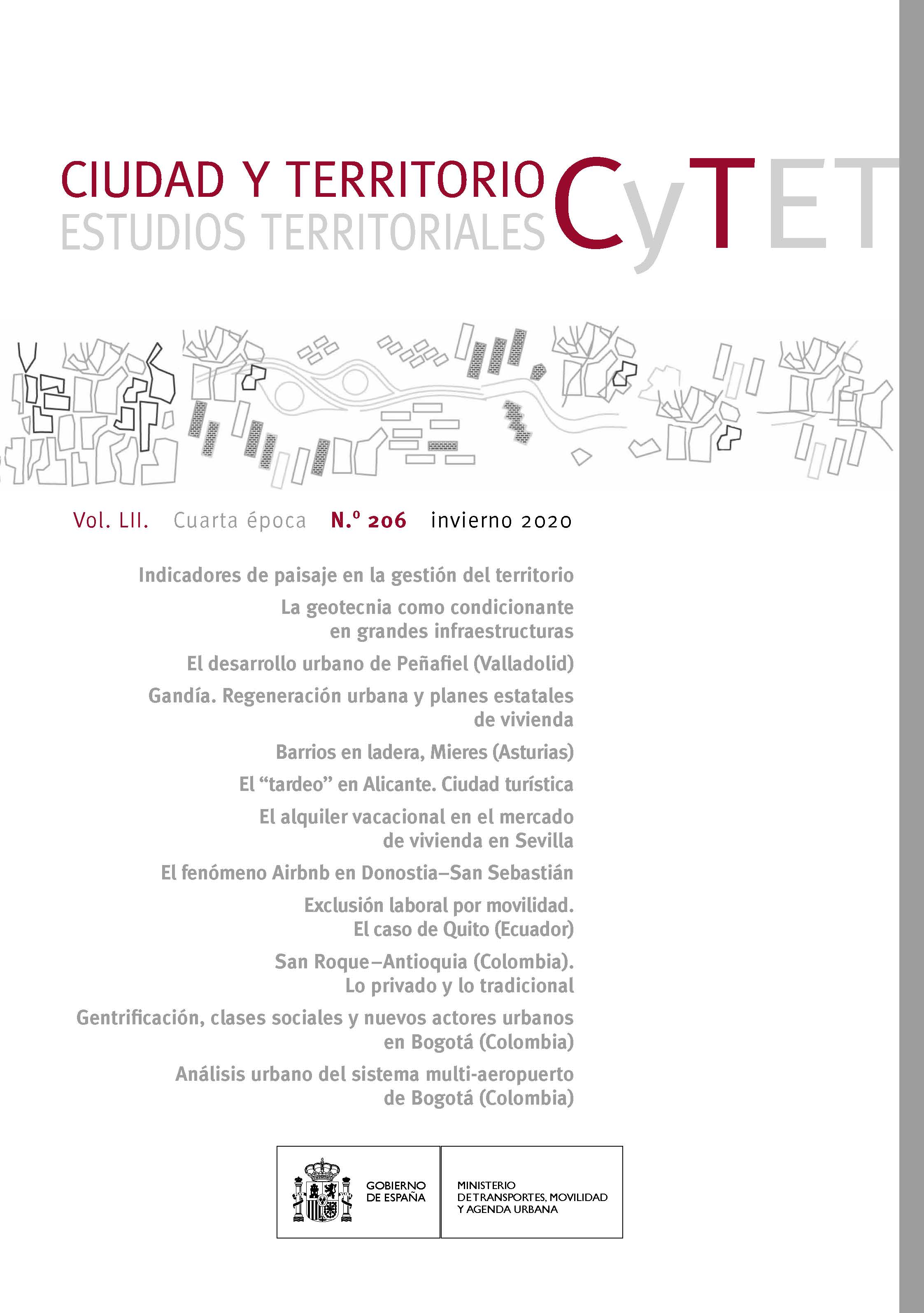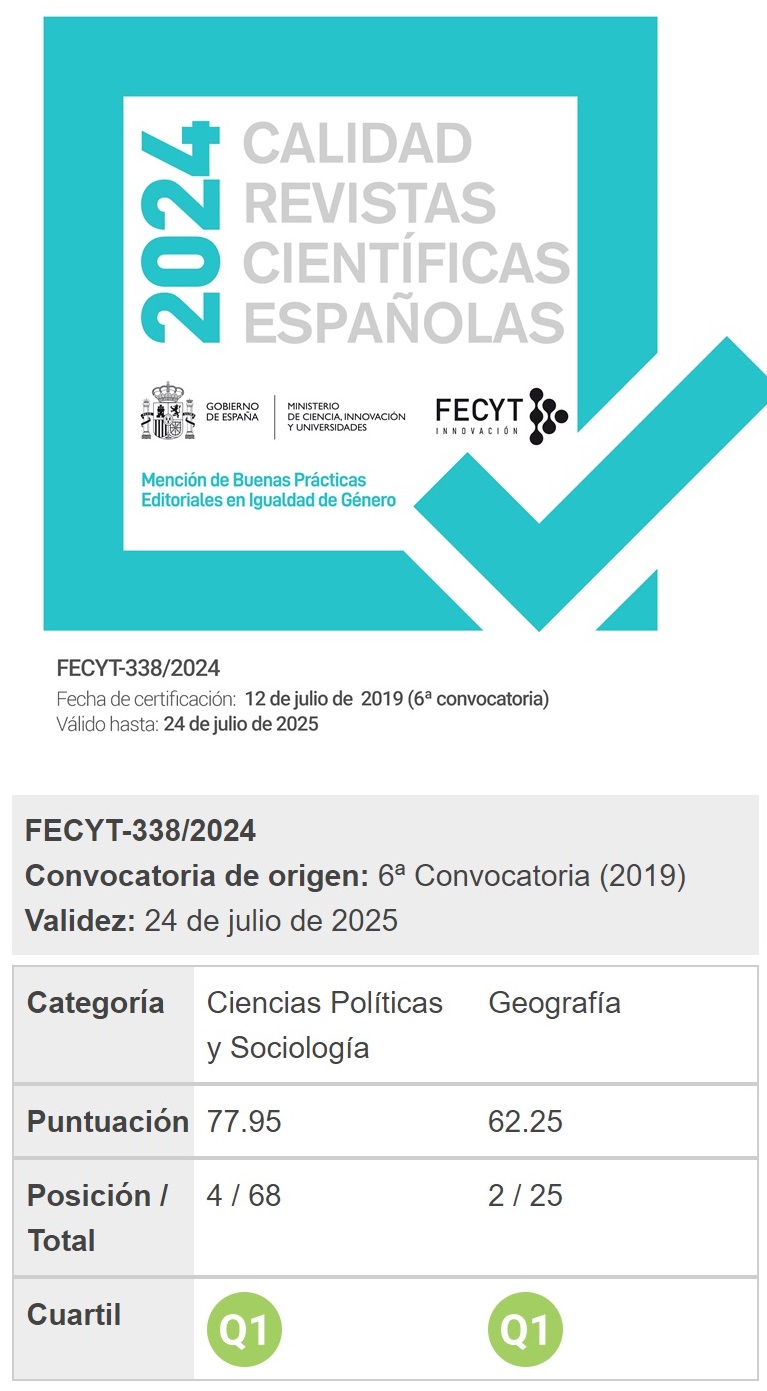Análisis urbano del próximo sistema multi-aeropuerto de la ciudad de Bogotá (Colombia)
DOI:
https://doi.org/10.37230/CyTET.2020.206.12Palabras clave:
Sistema multi-aeropuerto, Desarrollo urbano/territorial, Transporte aéreo, BogotáResumen
El Aeropuerto Internacional El Dorado en la ciudad de Bogotá (capital de Colombia) comenzó operaciones al final de la década de 1950 y a los pocos años empezó un importante desarrollo urbano en su entorno que se mantiene hasta el presente. Por otro lado, y desde la liberalización del transporte aéreo en el país (1991), el tráfico aéreo en el aeropuerto ha sido muy relevante, lo que llevó a la ejecución de dos ampliaciones del aeropuerto. La proyección de la demanda exige, a corto plazo, nuevas y relevantes ampliaciones del aeropuerto, pero fuertes restricciones (falta de suelo disponible y razones de carácter ambiental) hacen imposible cualquier nueva expansión. Por ello, y desde hace un lustro, está en marcha el desarrollo de un nuevo aeropuerto, por ahora conocido como El Dorado II, a 15 km del actual aeropuerto (y que se estima inicie operaciones en 2027/2028), y que servirá a la ciudad de Bogotá y zona de influencia. Entonces, en el presente artículo se realiza el análisis, con un enfoque urbano/territorial, del próximo sistema multi-aeropuerto para la ciudad de Bogotá.
Descargas
Citas
ACI-Airport Council International (2019): Annual World Airport Traffic Report. Montreal: Airport Council International.
Aerocivil (2008): Manual de atenuación de ruido de las aeronaves para el Aeropuerto Internacional El Dorado. Bogotá: Aerocivil.
Aerocivil (2009): El uso de suelos en áreas aledañas a aeropuertos. Bogotá: Aerocivil.
Aerocivil (2014a): Actualización del Plan Maestro del Aeropuerto Internacional El Dorado. Bogotá: Aerocivil.
Aerocivil (2014b): Estudio de impacto ambiental para la modificación de la licencia ambiental el Aeropuerto Internacional El Dorado de la Ciudad de Bogotá. Bogotá: Aerocivil.
Aerocivil (2016): Análisis técnico de la viabilidad operacional y elaboración del plan maestro aeroportuario para el proyecto de infraestructura El Dorado II. Bogotá: Aeronáutica Civil de Colombia (Aerocivil).
Aerocivil (2020): Estadísticas de actividades aeronáuticas. http://www.aerocivil.gov.co/atencion/estadisticas-de-las-actividades-aeronauticas
AIP (2013): Organización de la afluencia de tránsito aéreo (ENR 1.9). Bogotá: Aerocivil.
AIP (2019): AIP SKBO-Bogotá El Dorado. Bogotá: Aerocivil.
Alcaldía de Bogotá (2018): Aeropuerto El Dorado, retos y oportunidades. Perspectiva urbana y regional. Bogotá: Alcaldía de Bogotá.
Alkaabi, K. & Debbage, K. (2007): «Air passenger demand and skilled labor markets by US metropolitan area». Journal of Air Transport Management, 13(3), 121-130.
ANI (Agencia Nacional de Infraestructura) (2018): Factibilidad y Estructuración - APP Aeropuerto El Dorado II. Bogotá: Agencia Nacional de Infraestructura.
ANLA (2019): Auto N° 03169, del 17 de mayo de 2019. Bogotá: Autoridad Nacional de Licencias Ambientales de Colombia.
Appold, S. & Kasarda, J. (2013): «The airport city phenomenon: Evidence from large US airports». Urban Studies, 50(6), 1239-1259.
Ashford, N. & Mumayiz, S. & Wright, P. (2011): Airport Engineering. New Jersey: John Wiley & Sons.
Banai, R. (2017): «The aerotropolis: Urban sustainability perspectives from the regional city». The Journal of Transport and Land Use, 10(1), 357–373.
Bezerra, G. & Gomes, C. (2019): «Determinants of passenger loyalty in multi-airport regions: Implications for tourism destination». Tourism Management Perspectives, 31, 145-158.
Bonnefoy, P. & Hansman, R. (2007): «Scalability and Evolutionary Dynamics of Air Transportation Networks in the United States». AIAA Air Technology, Integration and Operations Conference, 2007, Belfast (UK).
Bonnefoy, P. P. & de neufville, R. & Hansman, R. (2010): «Evolution and Development of Multi-Airport Systems: A Worldwide Perspective». Journal of Transportation Engineering, 136(11), 1021-1029.
Boquet, Y. (2018): «From airports to airport territories: expansions, potentials, conflicts». Human Geographies-Journal of Studies and Research in Human Geography, 12(2), 137-156.
Brueckner, J. (2002): «Airport Congestion When Carriers Have Market Power». The American Economic Review, 92, 1357-1375.
Brueckner, J. (2003): «Air traffic and urban economic development». Urban Studies, 40(8), 1455-1469.
Budd, L. & Ison, S. (2017): Air transport management. New York: Routledge.
Burghouwt, G. (2017): «Influencing Air Connectivity Outcomes». Roundtable on Capacity building through efficient use of existing airport infrastructure, 9-10 March 2017, Querétaro.
Burghouwt, G. G. & Redondi, R. (2013): «Connectivity in air transport networks: an assessment of models and applications». Journal of Transport Economics and Policy, 47(1), 35-53.
Button, K. & Taylor, S. (2000): «International air transportation and economic development». Journal of Air Transport Management, 6(4), 209-222.
CCB (2008a): Caracterización urbanística, social y ambiental del entorno del Aeropuerto Internacional El Dorado. Bogotá: Cámara de Comercio de Bogotá.
CCB 2008b): Aeropuerto El Dorado, una oportunidad para el desarrollo regional. Bogotá: Cámara de Comercio de Bogotá.
CEDINS (2011): Macroproyecto Urbano Regional Aeropuerto El Dorado - MURA. Componentes, impactos y propuestas sociales. Bogotá: CEDINS.
CEPAL (2019): Airport infrastructure in Latin America and the Caribbean. Bulletin 370.
Cooper, A. & Smith, P. (2005): The economic catalytic effects of air transport in Europe. Final report EEC/SEE/2005/004. Brussel: Eurocontrol.
Cundinamarca (2020): RegioTram. https://efr-cundinamarca.gov.co/es
DANE (2019): Departamento Administrativo Nacional de Estadística. https://www.dane.gov.co/
De Neufville, R. (1984). «Planning for Multiple Airports in a Metropolitan Region». Built Environment, 10(3), 159-167.
De Neufville, R. (1995): «Management of multi-airport systems. A development strategy». Journal of Air Transport Management, 2(2), 99-110.
De Neufville, R. & Odoni, A. (2013) : Airport Systems, Planning, Design, and Management. New York: McGrawHill.
Díaz Olariaga, O. (2016): «Análisis del desarrollo reciente del transporte aéreo en Colombia». Revista Transporte y Territorio, 14, 122-143.
Díaz Olariaga, O. (2017): «Políticas de privatización de aeropuertos. El caso de Colombia». Documentos y Aportes en Administración Pública y Gestión Estatal, 29, 7-35.
Díaz Olariaga, O. (2018): «Análisis de mitigación de ruido aeroportuario. El caso del Aeropuerto Internacional de Bogotá-El Dorado (Colombia)». Ciudad y Territorio, 197, 557-576.
Díaz Olariaga, O. & Ávila J. (2015): «Evolution of the airport and air transport industry in Colombia and its impact on the economy». Journal of Airline and Airport Management, 5(1), 39-66.
Díaz Olariaga, O. & Rodríguez, Y. & Muñoz, C. (2018a): «Análisis de perfil de usuario y de accesibilidad al aeropuerto». XX Congreso Panamericano de Ingeniería de Tránsito, Transporte y Logística, 26-28 Septiembre 2018, Medellín (Colombia).
Díaz Olariaga, O. & Gavilán, A., & Ortíz, C. (2018b): «Accesibilidad vial al aeropuerto. El caso del Aeropuerto de Bogotá-El Dorado». XX Congreso Panamericano de Ingeniería de Tránsito, Transporte y Logística, 26-28 septiembre 2018, Medellín (Colombia).
DNP (2007): CONPES 3490-Estrategia institucional para el desarrollo del macroproyecto urbano - regional del Aeropuerto El Dorado de Bogotá. Bogotá: Dirección Nacional de Planeación.
Fasone, V. & Giuffre, T. & Maggiore, P. (2012): «Multi-Airport System as a Way of Sustainability for Airport Development: Evidence from an Italian Case Study». Procedia-Social and Behavioral Sciences, 53, 96-105.
Figueroa, O. & Rozas, P. (2005): Conectividad, ámbitos de impacto y desarrollo territorial: el caso de Chile. Santiago de Chile: CEPAL.
Fuellhart, K. & O’connor, K. & Woltemade, C. (2013): «Route-level passenger variation within three multi-airport regions in the USA». Journal of Transport Geography, 31, 171-180.
GaWC (2019a): Globalization and World Cities Research Network. https://www.lboro.ac.uk/gawc/
GaWC (2019b): The World According to GaWC 2018. https://www.lboro.ac.uk/gawc/world2018t.html
Goetz, A. (1992): «Air passenger transportation and growth in the U.S. urban system, 1950–1987». Growth and Change, 23, 218-242.
Green, R. (2007): «Airports and economic development». Real Estate Economics, 35(1), 91-112.
Horonjeff, R. & al. (2010): Planning and Design of Airports. New York: McGrawHill.
IATA (2019): World Air Transport Statistics. Geneva: IATA.
ICAO (2008): Guidance on the Balanced Approach to Aircraft Noise Management. Montreal: ICAO
Janic, M. (2009): Airport analysis, planning and design: demand, capacity and congestion. New York: Nova Science Publishers.
Kazda, A. & Caves, R. (2015): Airport design and operations. Bingley: Emerald.
Knippenberger, U. & Wall, A. (2010): Airports in Cities and Regions. Karlsruhe: KIT Scientific Publishing.
Liu, Z. & Debbage, K. & Blackburn, B. (2006): «Locational determinants of major US air passenger markets by metropolitan area». Journal of Air Transport Management, 12, 331-341.
Martin, J.C. & Voltes-Dorta, A. (2011). «The dilemma between capacity expansions and multi-airport systems: empirical evidence from the industry’s cost function». Transportation Research, 47(3), 382-389.
Minambiente (2019): Resolución 627 del 7 de Abril de 2006. Bogotá: Ministerio de Ambiente y Desarrollo Sostenible (Colombia).
Mun, S. & Teraji, Y. (2012): «The organisation of multiple airports in a metropolitan area». Journal of Transport Economics and Policy, 46(2), 221-237.
NASA (2011): Investigating the nature of and methods for managing metroplex operations. Hanover (MD): NASA Center for AeroSpace Information.
NEAL, Z. (2012): «Creative employment and jet set cities: disentangling causal effects». Urban Studies, 49, 2693-2709.
OACI (2002): Manual de Planificación de Aeropuertos. Parte 2: Utilización del terreno y control del medio ambiente. Montreal: OACI.
Pels, E. & Verhoef, E. (2004): «The Economics of Airport Congestion Pricing». Journal of Urban Economics, 55, 257-277.
Postorino, M. (2010). Development of Regional Airports. Southampton: WIT Press.
Postorino, M. & Pratico, F. (2012): «An application of the Multi-Criteria Decision-Making analysis to a regional multi-airport system». Research in Transportation Business & Management, 4, 44-52.
Rozas, P. & Figueroa, O. (2006): Conectividad, ámbitos de impacto y desarrollo territorial: análisis de experiencias internacionales. Santiago de Chile: CEPAL.
Sánchez, G. A. (2011): «Incidencia del aeropuerto Eldorado en la estructura espacial de la ciudad de Bogotá, periodo 1990–2010». Perspectiva Geográfica, 16, 173-196.
SDM (2015): Informe de Indicadores Encuesta de Movilidad de Bogotá. Bogotá: Secretaria Distrital de Movilidad, Alcaldía de Bogotá.
Van De Vijver, E. & Derudder, B. & Witlox, F. (2016): «Air passenger transport and regional development: cause and effect in Europe». Promet – Traffic & Transportation, 28(2), 143-154.
Vasigh, B. & Fleming, K. & Tacker, T. (2013): Introduction to Air Transport Economics. Burlington: Ashgate Publishing.
Zak, D. & Getzner, M. (2014): «Economic effects of airports in Central Europe: A critical review of empirical studies and their methodological assump-tions». Advances in Economics and Business, 2(2), 100-111.
Zhang, A. & Zhang, Y. (2006): «Airport Capacity and Congestion When Carriers Have Market Power». Journal of Urban Economics, 60, 229-247.
Zietsman, D. & Vanderschuren, M. (2014): «Analytic Hierarchy Process assessment for potential multi-airport systems - The case of Cape Town». Journal of Air Transport Management, 36, 41-49.
Publicado
Cómo citar
Número
Sección
Licencia
Derechos de autor 2020 Óscar Díaz-Olariaga

Esta obra está bajo una licencia internacional Creative Commons Atribución-NoComercial 4.0.
Sin perjuicio de lo dispuesto en la legislación vigente sobre Propiedad Intelectual, y conforme a la misma, el/la los/las autor/a/es/as que publiquen en CyTET cede/n a título gratuito, de modo no exclusivo y sin límite temporal al Ministerio de Transportes, Movilidad y Agenda Urbana los derechos para difundir, reproducir, comunicar y distribuir en cualquier formato actual o futuro, en papel o electrónico, la versión original o derivada de su obra bajo licencia de Creative Commons Reconocimiento-NoComercial-SinObraDerivada 4.0 Internacional (CC BY-NC-ND 4.0), así como para incluir o ceder a terceros la inclusión de su contenido en índices, repositorios y bases de datos nacionales e internacionales, con referencia y reconocimiento en todo caso de la autoría del mismo.
Además, al realizar el envío, el/la los/las autor/a/es/as declara/n que se trata de un trabajo original en el que se reconocen las fuentes que han sido utilizadas en su estudio, comprometiéndose a respetar la evidencia científica y a no modificar los datos originales para verificar o refutar una hipótesis de partida; que el contenido esencial del mismo no ha sido publicado previamente ni se publicará en ninguna otra obra o revista mientras esté en proceso de evaluación en la revista CyTET; y que no se ha remitido simultáneamente a otra publicación.
Los autores deben firmar un Formulario de Cesión de Derechos, que les será enviado desde la Secretaría de CyTET una vez se acepte su artículo para ser publicado.
Con el objetivo de favorecer la difusión del conocimiento, CyTET se adhiere al movimiento de revistas de Open Access (OA) y entrega la totalidad de sus contenidos a diversos índices, repositorios y bases de datos nacionales e internacionales bajo este protocolo; por tanto, la remisión de un trabajo para ser publicado en la revista presupone la aceptación explícita por parte del autor/a de este método de distribución.
Se anima a las/os autoras/es a reproducir y alojar sus trabajos publicados en CyTET en repositorios institucionales, páginas web, etc. con la intención de contribuir a la mejora de la transferencia del conocimiento y de la citación de dichos trabajos.








 Enlace a CyTET en Linkedin
Enlace a CyTET en Linkedin